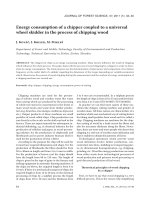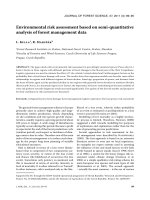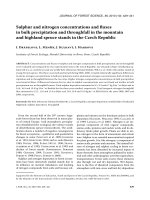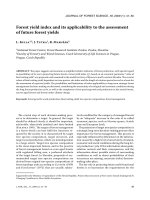Báo cáo lâm nghiệp: "Forest vegetation management (FVM) is key to successful forest stand establishment around the world" doc
Bạn đang xem bản rút gọn của tài liệu. Xem và tải ngay bản đầy đủ của tài liệu tại đây (28.88 KB, 1 trang )
558
Ann. For. Sci. 60 (2003) 558
© INRA, EDP Sciences, 2003
Foreword
Forest vegetation management (FVM) is key to successful
forest stand establishment around the world. Levels of invest-
ment in FVM are determined by the silvicultural intensity
desired. FVM also is vital in the mixed production systems of
agro-forestry. FVM includes a wide variety of practices that
involve a number of questions about biologic and economic
justifications, appropriate methods and timing of application,
growth and yield implications, concerns about environmental
consequences, and public acceptability.
The 4th International Conference on Forest Vegetation
Management (IFVMC), held in Nancy (France) from 17 to
21 June 2002, dealt with many of these questions. The conference
emphasized the ecological consequences of FVM. The robust
response of forest vegetation to FVM practices illustrates the
tremendous capacity of native flora to adapt to new environ-
mental conditions, but also reflects the nature of past events
during past centuries. Influences of FVM practices on vegeta-
tion diversity were of particular interest. Forest vegetation
manipulation can be used as a tool of ecological management
to restore wild habitat or river quality, or to improve the pro-
ductive capacity of a site. FVM often modifies the habitat of
wild animals in favor of one or another species according to
structure and composition of the plant communities created.
Spatial and time scales also need to be taken into account when
analyzing the consequences of perturbations to forest plant
communities.
Conference speakers emphasized the need for diversifica-
tion and optimization of FVM practices. Public opposition to
forest use of herbicides, although not fully justified according
to the assessment of risks by scientists (as underlined by sev-
eral works), is now considered as reality and serves as an
impetus to explore new methods of FVM. Work to integrate
current data into models that will facilitate optimizing the rel-
ative efficiency of herbicides and to reduce the environmental
impact is progressing. Research on the development of herbi-
cides produced from naturals compounds, use of pathogenic
organisms (for example to control woody plants), and the
development of new concepts founded based on a sound
understanding forest succession continues. Research on new
methods for FVM should increase and will require a substan-
tial research effort.
A strong aspect of this 4th international conference was the
presentations regarding ecological relationships between trees
and associated vegetation. Results from long-term studies
continue to show how much forest yields can be increased
with FVM. The results are consistent for a wide range of tree
species and site conditions. These large responses continue to
show that the current understanding of site index or site pro-
ductivity is inadequate and requires further research. Original
research combining several controlled factors including water,
light, microclimate, nutrients or indirect factors such as asso-
ciated fauna are assisting in interpreting the complexity of
plant interference. It is an ongoing challenge to translate this
information into an operational context that can be applied in
general situations. Conference participants identified the need
to develop general models that are capable of assembling our
current information into a set of testable hypotheses that can
advance the field of FVM.
Socioeconomic aspects of FVM also were addressed at the
conference. Studies presented sought to identify the relation-
ship between FVM and various social goals. The perceived
conflict between goals of wood production and other functions
supported by public opinion were discussed. Public perception
is defined by value systems and other motivation that brings a
variety of perspectives to the issues. Including social and eco-
logical aspects often involves imposing constraints and addi-
tional costs that are not generally compensated in the price
received for wood, with advantages and disadvantages often
accruing differently among regions depending on the degree
of social concern. Emerging sustainable forestry certification
systems are providing one way to address concerns and costs.
FVM information systems can provide a way to manage mul-
tiple functions at various temporal and spatial scales. This
approach, however, needs to integrate information concerning
socioeconomic, and the dynamics of renewable resources.
This area of research is largely an open domain.
The 4th IFVMC brought 130 participants from 22 countries.
Nearly 150 (oral or poster) presentations were delivered and
were published in a book of Popular Summaries of the confer-
ence (to order: ). This special issue of
Annals of Forest Science contains 20 articles reviewed accord-
ing to the usual criteria of the journal. Several articles will be
published in following issues of the journal. Synthesis of
conference is available on the ifvmc web site: www.ifvmc.org
The conference was lead by Henri Frochot, Catherine Collet
(INRA, France) and Philippe Balandier (Cemagref, France), in
collaboration with Robert Campbell (Canadian Forest Service),
Paul Christensen (PC Consul, Denmark), Michael Newton
(Oregon State University, USA), Dean Thompson (Canadian
Forest Service, Canada) and Robert Wagner (University of
Maine, USA) for the Scientific Committee, the Association
Française de Protection des Plantes (afpp, France) for admin-
istration, and Organizing Committee for all logistics and tours.
The conference was sponsored by IUFRO in the scope of
the work group PI 13 00, Forest Vegetation Management,
chaired by Robert Wagner. Previous conferences held on 1992
in Auburn (Alabama, USA), 1995 in Rotorua (New Zealand),
1998 in Sault Ste. Marie (Ontario, Canada).
Major support were provided by: INRA, Cemagref, Direc-
tion des Forêts du Ministère de l’Agriculture, Ministère de la
culture, AFPP, Canadian Forest Service, ONF, Communauté
Urbaine du Grand Nancy, Région Lorraine, Ville de Nancy,
UIPP.
Henri Frochot, Catherine Collet,
Philippe Balandier and Robert Wagner









